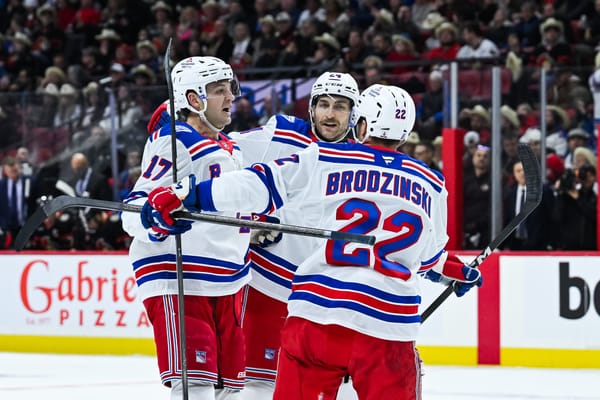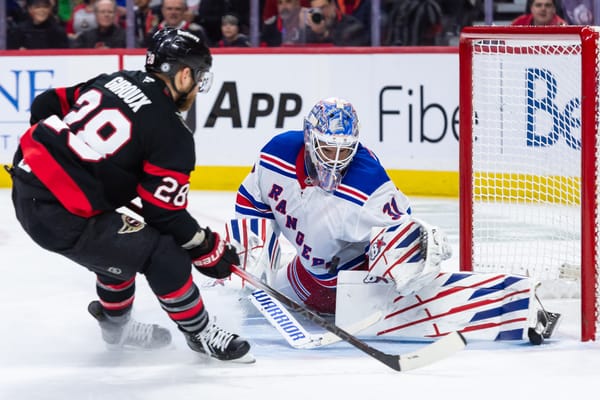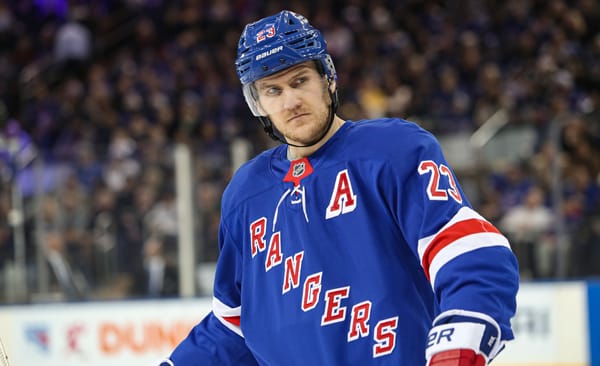Column: Is the game getting any cleaner?
Is the NHL’s current method of penalizing players doing enough to deter dirty, reckless play?
It’s been a long time since we’ve seen a New York Ranger miss time as a result of supplementary discipline. The last major suspension earned by a Ranger took place in the 2014 Playoffs; on May 22 Dan Carcillo earned an automatic suspension — that was later reduced from 10 games to six — for the abuse of an official. Yep, it’s never a good idea to get into it with an official.
The most recent suspension attached to a player wearing a Rangers jersey belongs to a guy who never signed a real contract. Andrew Desjardins, who was playing for the Rangers in the 2017 preseason on a PTO, earned a two game suspension for his hit to the head of Miles Woods of the New Jersey Devils during the 2017 preseason.
Right now you might be thinking, “The Rangers have only had two suspensions since May 2014? Where the heck is this article going?” Well, they may have a relatively clean record over the last few years, but the same cannot be said of the NHL as a whole.
Where We Are Now
Last year there were 28 total suspensions. Those suspensions resulted in NHL players missing 87 games, including games in the preseason and playoffs along with the regular season. Two years ago, the league handed out 28 suspensions for a cumulative penalty of 85 games. NHL players missed over 200 games in the 2015-16 season, but that number was inflated by Raffi Torres’ 41-game ban and four other suspensions of 19 games or more.
The fact that we had the same number of suspensions last season as 2016-17 may not sound like cause for concern or alarm, but it certainly isn’t a sign of progress. Two years ago the NHL fined 13 of its players for infractions; six of those infractions involved physical violence directed towards another player. Last season we saw 33 fines, and at least 15 of them involved physical violence directed towards another player. Again, not exactly a sign of progress.
It’s important to note that last season was George Parros’s first as the head of the Department of Player Safety. He’s also the reason why we saw more fines for slashing and cross-checking than ever before. “We used to be worried about headhunting and major things like that,” Parros said last September, “Now we’re worried about slashing and some more minor infractions, you might say. So the game’s in a good place. There doesn’t need to be a huge shake-up, a huge change in philosophy.”
Parros also made it clear last September that he didn’t want to take physicality out of the game. As it turns out, the former enforcer had nothing to worry about. There was no shortage of physicality — both legal and illegal — last season.
There were seven suspensions for boarding and five suspensions for illegal checks to the head last year. In 2016-17 there were five bans for boarding and five for illegal checks to the head — and those were just the plays that warranted suspensions. There may be less true headhunting than there was a few years ago, but there are still head shots. Dirty hits that show no respect for opposing players are still a big problem in the NHL.
Teams Aren’t Changing
Part of the greater problem here is that teams are still giving contracts to repeat offenders. This offseason the Washington Capitals rewarded Tom Wilson with a six-year, $31 million deal. Wilson’s deal wasn’t just eyebrow-raising because of his modest production; he signed that contract after earning a league-leading three suspensions in 2017-18.
Wilson wasn’t the only repeat offender to get a contract this summer. The Nashville Predators signed Zac Rinaldo to a one-year, two-way deal. Rinaldo has been suspended four times since April 6, 2014, including a six-game suspension last season for punching an unsuspecting Sam Girard in the face. Somehow, David Poile convinced himself that Rinaldo was worth a possible $650,000 investment on the second day of the 2018 offseason.
Zac Rinaldo career goals: 11
— Dimitri Filipovic (@DimFilipovic) December 28, 2017
Zac Rinaldo career games suspended: 25
The number of fucks the league seems to give: 0
Of course, it’s not just the guys like Matt Cooke, Torres, Wilson, and Rinaldo who frequently cross(ed) the line. There are a fair share of exceptionally talented players like Brad Marchand, Nazem Kadri, and Gabriel Landeskog who are also repeat offenders.
The Bruins knew what they were getting into when they signed Marchand to an eight-year deal before the 2016-17 season. He’s missed 15 games due to suspensions and has been fined four times since the 2014-15 season. Last year Marchand earned a five-game ban for a flying elbow delivered to the head of an unsuspecting Marcus Johansson. That indefensible act cost the winger $373,475.61 in salary. It was his sixth career suspension, and it would be foolhardy to assume that it will be his last given his track record.
A Matter of Priority
Before we go any further, let’s make something perfectly clear: there will always be dangerous plays in hockey; the speed of the game makes it a disturbingly successful recipe for concussions and other injuries. However, that doesn’t change the fact that the league must do everything it can to reduce injuries and protect its players. And a big part of protecting players is employing punitive measures to discourage dirty and excessively dangerous play.
The Department of Player Safety has a very tough job. They have to dole out bans and fines in the hopes that they will discourage infractions, preserve the integrity of the game, and protect players. Unfortunately, it’s all too easy to become frustrated with some of the decisions that are made by Parros and his colleagues.
On Nov. 2 Kevin Hayes was chirping at Alex Killorn from the Rangers bench and squirted his water bottle at him. Killorn responded by turning around and jabbing at Hayes with his stick. Both players received a $5,000 fine, the maximum allowable under the CBA. Earlier in the season Matt Dumba of the Minnesota Wild also received a $3,000 fine — again, the maximum allowable under the CBA — for spraying an opponent with his water bottle.
As far as I can tell, all of the fines handed out by the Department of Player Safety last season were for the maximum amount allowed under the CBA. Which means that players who had impromptu water gun fights were fined just as much as players who butt-ended, boarded, cross-checked, and dangerously tripped opposing players. It goes without saying that there is a huge difference between spraying someone with water and jamming the butt end of your stick into their ribs. One is harmless; the other could result in serious injury.
It would appear that Parros and company are adopting a “zero tolerance” policy for infractions of any kind. However, the only noticeable trend over the last three years is a significant drop in the fines for diving. There were 11 fines for diving/embellishment in 2015-16; six fines in 2016-17; and four fines last season. So, players are flopping less than they were three years ago, but are still targeting each other’s heads and boarding each other just as much.
Maybe it is time for a huge change in philosophy.
A Hard Line
If the NHL wants headhunting and boarding out of the game, they need to consider more drastic punitive measures — and not just for repeat offenders.
How many unnecessary concussions and blown-out knees does a historically reckless player need to be responsible for before we start seeing more 10, 15, or 20 game bans? Why did Wilson only get three games for driving his shoulder into Zach Aston-Reese’s head on May 1, 2018 after earning two suspensions in the 2017 preseason — especially after a questionable hit just one game before that didn’t receive any supplemental discipline? This isn’t just a lack of consistency; it’s the league not following its own guidelines.
For those who are unfamiliar with the guidelines regarding repeat offenders, they can be found in Article 18 (Section 18.2) of the CBA.
(a) The type of conduct involved: conduct in violation of League Playing Rules, and whether the conduct is intentional or reckless, and involves the use of excessive and unnecessary force. Players are responsible for the consequences of their actions.
(b) Injury to the opposing Player(s) involved in the incident.
(c) The status of the offender and, specifically, whether the Player has a history of being subject to Supplementary Discipline for On-Ice Conduct. Players who repeatedly violate League Playing Rules will be more severely punished for each new violation.
(d) The situation of the game in which the incident occurred, for example: late in the game, lopsided score, prior events in the game.
(e) Such other factors as may be appropriate in the circumstances.
When the NHL suspended Radko Gudas 10 games for his two-handed chop to Mathieu Perreault’s neck last season, it was clear that his reputation played a role in the length of his ban. Specifically, the league cited Gudas’ six-game ban from Oct. 2016 as evidence that Gudas was a repeat offender.
So, why did Wilson — another repeat offender — only get three games for his head shot on Aston-Reese? And why did Kadri only get three games for boarding a defenseless Tommy Wingels on Apr. 12, 2018 with his own history of suspensions and fines? Perhaps it’s because Wilson and Kadri’s dirty plays happened in the playoffs. It’s worth mentioning that the other four suspensions from the 2017 Playoffs were all one-game bans.
In no way should there be a different standard for supplementary discipline in the postseason, even though those games carry more weight than a single regular season tilt. This is something that the league and the Department of Player Safety needs to get right. If offending players start getting 10-game bans for crossing the line in the playoffs, it stands to reason that we will start to see less suspension-worthy offenses.
Don’t think it will work? When was the last time we saw a stick fight break out on the ice? It stands to reason that the harsher the penalties are, the cleaner the game will become.
As much as some of us may like to, we can’t let players take justice into their own hands. We know that it simply doesn’t work. The fallout after any hit that is perceived to be late or high (or both) has become downright formulaic. The victim’s nearest and/or toughest teammate will immediately challenge the offending party; gloves will be dropped, punches will be traded, and nothing will change beyond the perception that a message was sent. Lather, rinse, repeat.
The bottom line is that the systems that are currently in place, both formal and informal, don’t do enough to deter cheap shots, head shots, and dirty play.
An Unfortunate Opportunity on the Horizon
No one wants to talk about it, but we are currently on a collision course with yet another lockout. As frustrating as that process is going to be for everyone, it also presents an important opportunity to reform supplementary discipline. In other words, there’s no better time to clean up the game than right now — or, uh, two or three years from now.
Longer bans and more significant fines may sound like reasonable steps to take to clean up the game, but players aren’t going to like it. And they may fight it tooth and nail. Longer bans would mean more salary forfeited and, obviously, the same would be true of bigger fines. That’s a tough pill to swallow, but might it be worth it to the players if they believed it was the best way to clean up the game?
Another possibility could be establishing punitive measures for teams that go beyond losing a player for the number of games that they are suspended. But, what would that look like? Maybe fines or something like the forfeiture of waiver priority? It’s unlikely that either of those measures would carry much weight. Perhaps the best punishment for teams would be the risk of continuing to employ a player who is one suspension away from missing 15 or 20 games because he’s a repeat offender.
These ideas likely sound drastic and perhaps even unrealistic to you. But if we want to accelerate the learning curve of players and make it abundantly clear that rule infractions — especially those that put others into danger — will not be tolerated, drastic measures are the best tools we have.
No, this doesn’t mean taking the hitting out of hockey. And no, this doesn’t mean changing the game at the fundamental level. It means changing our philosophy about supplementary discipline. It means holding players accountable for their actions and demanding that they learn from their mistakes. It means cleaning up the game, the hard way.




